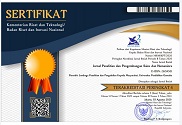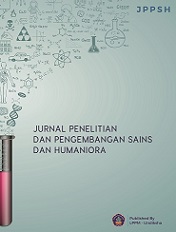The Poverty Level in Yogyakarta City: Examining the Influencing Factors with a Multidimensional Approach
DOI:
https://doi.org/10.23887/jppsh.v8i3.84142Keywords:
Poverty Level, Yogyakarta City, Multidimensional ApproachAbstract
Poverty is a complex issue that requires an in-depth understanding of the various factors influencing it. This study aims to analyze the poverty level in Yogyakarta City using a multidimensional approach, as well as identify the factors contributing to this condition. The study employs a quantitative method, with data collected through an empirical survey using structured questionnaires. The respondents of this study are the beneficiaries of the Kartu Maju Sejahtera (Prosperous Advance Card) in Yogyakarta City, Special Region of Yogyakarta. The collected data were analyzed using Smart PLS4 software, with hypothesis testing on variables such as public policy, asset ownership, health, income, and education. The results show that public policy does not have a significant impact on poverty levels. On the other hand, asset ownership, health, income, and education have a significant influence on poverty levels and play an important role. Higher education is strongly correlated with a reduction in poverty levels, while effective public policies, although important, show limitations in their implementation. Moreover, health has a significant impact, but limited access to healthcare services affects the statistical results. The study concludes that increasing income could be a key solution to reducing poverty. These findings emphasize the importance of a multidimensional approach to understanding poverty, highlighting that non-economic factors such as education, health, and asset ownership also play vital roles in determining the welfare of the community. The study provides implications for policymakers to integrate more holistic strategies in poverty alleviation efforts.
References
Agustin, I. W., & Hariyani, S. (2023). Pengelolaan infrastruktur kota dan wilayah. Universitas Brawijaya Press.
Albagoury, S. H. (2021). African pathway to achieve inclusive growth: COMESA case study. Journal of Humanities and Applied Social Sciences, 3(2), 108–119. https://doi.org/10.1108/jhass-03-2020-0045.
Ambya, A., & Ciptawaty, U. (2022). Hubungan antara belanja pemerintah, tingkat kemiskinan, dan pertumbuhan ekonomi daerah otonomi baru di Provinsi Lampung. Jurnal Paradigma Ekonomika, 17(1), 157–166. https://doi.org/10.22437/jpe.v17i1.17747.
Amponsah, M., Agbola, F. W., & Mahmood, A. (2023). The relationship between poverty, income inequality and inclusive growth in Sub-Saharan Africa. Economic Modelling, 126(October 2022), 106415. https://doi.org/10.1016/j.econmod.2023.106415.
Anwar, M. (2022). Green Economy Sebagai Strategi Dalam Menangani Masalah Ekonomi Dan Multilateral. Jurnal Pajak Dan Keuangan Negara (PKN), 4(1S), 343–356. https://doi.org/10.31092/jpkn.v4i1s.1905.
Apera, I., Daniel, A., Balogun, M., Mohammed, M., Lawal, A., Abdullahi, K., & Nongo, S. (2021). National social register: An approach to social protection and poverty reduction in Nigeria. Radic. Stat. Newsl, 129, 29–44.
Asiedu, M., Effah, N. A. A., & Aboagye, E. M. (2023). Finance, poverty-income inequality, energy consumption and the CO 2 emissions nexus in Africa . Journal of Business and Socio-Economic Development, 3(3), 214–236. https://doi.org/10.1108/jbsed-12-2021-0167.
Asongu, S., & Agyemang-Mintah, P. (2024). The relationship between inequality and poverty in developing countries: mitigating role of virtual social network and internet access in schools. International Journal of Social Economics. https://doi.org/10.1108/IJSE-09-2023-0695.
Azhari, I. M., & Retno Faridatussalam, S. (2023). Analisis Faktor Yang Mempengaruhi Kemiskinan Tahun 2016-2021: Studi Kasus di Provinsi Daerah Istimewa Yogayakarta. Primanomics : Jurnal Ekonomi & Bisnis, 21(3), 31–40. https://doi.org/10.31253/pe.v21i3.1886.
BPS Kota Yogyakarta. (2023). Kota Yogyakarta dalam Angka 2023. Sustainability (Switzerland), 11(1), 1–14.
Choi, Y. J., & Leelasribunjong, Y. (2024). Asymmetric effects of GVC on poverty in ASEAN and OECD. International Trade, Politics and Development, 8(2), 82–95. https://doi.org/10.1108/itpd-05-2024-0027.
DeVellis, R. F., & Thorpe, C. T. (2021). Scale development: Theory and applications. Sage publications.
Diaz, L., Trees, F. P., Reed, D., Kick, R., & Kuemmel, A. (2024). Social Justice and Equity in CS Education. 653–654. https://doi.org/10.1145/3017680.3017693.
Faharuddin, & Endrawati, D. (2022). Determinants of working poverty in Indonesia. Journal of Economics and Development, 24(3), 230–246. https://doi.org/10.1108/JED-09-2021-0151.
Faharuddin, F., Yamin, M., Mulyana, A., & Yunita, Y. (2023). Impact of food price increases on poverty in Indonesia: empirical evidence from cross-sectional data. Journal of Asian Business and Economic Studies, 30(2), 126–142. https://doi.org/10.1108/JABES-06-2021-0066.
Faletehan, A. F., Mauludin, M. F., & Hakim, A. K. (2022). Studi Kualitatif tentang Jebakan Kemiskinan pada Masyarakat Pesisir di Pasuruan, Jawa Timur. Buletin Ilmiah Marina Sosial Ekonomi Kelautan Dan Perikanan, 8(1), 73. https://doi.org/10.15578/marina.v8i1.10960.
Fauziah, D. R., & Sarkani, S. (2023). Analisis Perbandingan Sistem Ekonomi Kapitalis Dengan Ekonomi Islam. Aksioma Al-Musaqoh, 6(2), 1–14. https://doi.org/10.55171/jam.v6i2.961.
Ferdous, J. (2021). COVID-19 in South and South East Asia. Southeast Asia: A Multidisciplinary Journal, 21(2), 83–94. https://doi.org/10.1108/seamj-02-2021-b1006.
Frennesson, L., Kembro, J., de Vries, H., Van Wassenhove, L., & Jahre, M. (2021). Localisation of logistics preparedness in international humanitarian organisations. Journal of Humanitarian Logistics and Supply Chain Management, 11(1), 81–106. https://doi.org/10.1108/JHLSCM-06-2020-0048.
Fuady, M., Fuady, M. R. F., & Aulia, F. (2022). Kemiskinan Multi Dimensi dan Indeks Pembangunan Manusia di Indonesia. TATALOKA, 24(4), 330–337. https:/doi.org/10.14710/tataloka.24.4.330-337.
Gao, F. (2021). China’s poverty alleviation “miracle” from the perspective of the structural transformation of the urban–rural dual economy. China Political Economy, 4(1), 86–109. https://doi.org/10.1108/cpe-06-2021-0008.
Häkkilä, L., Seppälä, P., Hietamäki, J., & Toikko, T. (2022). Financial support for households and the demand for child protection services – a municipality-level analysis of income support for single-parent households and reimbursements for depression medicines. International Journal of Sociology and Social Policy, 42(13–14), 50–65. https://doi.org/10.1108/IJSSP-06-2022-0165.
Herbert Robert, E. (2023). An econometric analysis of modernized cereal production in reducing multidimensional poverty in Uganda, 1975-2014. Review of Economics and Political Science. https://doi.org/10.1108/REPS-04-2020-0051.
Ikbal, M., Dewi, N. D. T., & Syaifuddin, H. (2023). Problematika Ekonomi Kapitalis dan Sosialis Perspektif Ismail Raji Al-Faruqy. Jurnal Ilmiah Ekonomi Islam, 9(1), 1197–1203. https://doi.org/10.29040/jiei.v9i1.7046.
Islam, M. S., & Azad, A. K. (2024). The impact of personal remittance and RMG export income on income inequality in Bangladesh: evidence from an ARDL approach. Review of Economics and Political Science, 9(2), 134–150. https://doi.org/10.1108/REPS-01-2023-0004.
Jové-LLopis, E., & Trujillo-Baute, E. (2024). The effect of regional factors on energy poverty. Applied Economic Analysis, 32(95), 167–185. https://doi.org/10.1108/AEA-01-2024-0019.
Ju, C., Hou, S., Shao, D., Zhang, Z., & Yu, Z. (2021). Practices of poverty alleviation by open and distance education: a case report from the Open University of China. Asian Association of Open Universities Journal, 16(3), 287–298. https://doi.org/10.1108/AAOUJ-09-2021-0110.
Junaidi, J. (2024). Islamic banks’ contribution to Indonesia districts’ economic growth and poverty alleviation. Journal of Economics, Finance and Administrative Science. https://doi.org/10.1108/JEFAS-06-2021-0097.
Laoh, Elvira Rosa. Kalangi, Josep Bintang. Siwu, H. F. D. (2023). Pengaruh Produk Domestic Regional Bruto Dan Indeks Pembangunan Manusia. Jurnal Berkala Ilmiah Efisiensi, 23(1), 85–96.
Noermanisa, T. (2023). Pengaruh Pendapatan Asli Daerah, Dana Perimbangan, Dan Pertumbuhan Ekonomi Terhadap Kemiskinan Di D.I. Yogyakarta. Journal of Development Economic and Social Studies, 2(3), 689–700. https://doi.org/10.21776/jdess.2023.02.3.19.
Osabohien, R., Matthew, O., Ohalete, P., & Osabuohien, E. (2020). Population–poverty–inequality nexus and social protection in Africa. Social Indicators Research, 151(2), 575–598.
Papilaya, J. (2020). Kebijakan Publik Dalam Pengentasan Kemiskinan (Suatu Kajian Peranan Pemerintah Dalam Pengentasan Kemiskinan). Jurnal Bimbingan Dan Konseling Terapan, 4(1), 77–91. https://doi.org/10.30598/jbkt.v4i1.1113.
Pasara, M. T., & Mhlanga, D. (2022). Accelerating sustainable development goals in the wake of COVID-19: The role of higher education institutions in South Africa. Emerald Open Research, 4, 30. https://doi.org/10.35241/emeraldopenres.14799.1.
Prabowo, P. A., Supriyono, B., Noor, I., & Muluk, M. K. (2021). Special autonomy policy evaluation to improve community welfare in Papua province Indonesia. International Journal of Excellence in Government, 2(1), 24–40. https://doi.org/10.1108/ijeg-06-2019-0011.
Pradilla, C. A., da Silva, J. B., & Reinecke, J. (2022). Wicked Problems and New Ways of Organizing: How Fe y Alegria Confronted Changing Manifestations of Poverty. In A. A. Gümüsay, E. Marti, H. Trittin-Ulbrich, & C. Wickert (Eds.), Organizing for Societal Grand Challenges (Vol. 79, pp. 93–114). Emerald Publishing Limited. https://doi.org/10.1108/S0733-558X20220000079007.
Rahman, A., Wasistiono, S., Riyani, O., & Tahir, I. (2023). Peran Organisasi Masyarakat (Ormas) dan Lembaga Swadaya Masyarat (LSM) dalam Pembangunan Berkelanjutan di Indonesia. Ekonomis: Journal of Economics and Business, 7(2), 1461. https://doi.org/10.33087/ekonomis.v7i2.1492.
Royce, E. (2022). Poverty and power: The problem of structural inequality. Rowman & Littlefield.
Seewald, E., Baerthel, S., & Nguyen, T. T. (2023). Land rental markets as a poverty reduction strategy: evidence from Southeast Asia. Journal of Economics and Development, 25(2), 102–119. https://doi.org/10.1108/JED-10-2022-0217.
Triono, T. A., & Sangaji, R. C. (2023). Faktor mempengaruhi tingkat kemiskinan di Indonesia: Studi literatur laporan data kemiskinan BPS Tahun 2022. Journal of Society Bridge.
Wao, H., Otendo, C. O., Syonguvi, J., Muriithi, P., Kadengye, D. T., & Brodin, E. M. (2022). Encouraging social innovation for combating poverty: master’s students’ gendered experiences with a service-learning intervention in Kenya and Uganda. Studies in Graduate and Postdoctoral Education, 13(2), 171–187. https://doi.org/10.1108/SGPE-07-2021-0054.
Wu, B., Niu, L., Tan, R., & Zhu, H. (2024). Multidimensional relative poverty alleviation of the targeted microcredit in rural China: a gendered perspective. China Agricultural Economic Review, 16(3), 468–488. https://doi.org/10.1108/CAER-06-2023-0167.
Downloads
Published
Issue
Section
License
Copyright (c) 2024 nursamsiyah

This work is licensed under a Creative Commons Attribution-ShareAlike 4.0 International License.
Authors who publish with the Jurnal Penelitian dan Pengembangan Sains dan Humaniora agree to the following terms:
- Authors retain copyright and grant the journal the right of first publication with the work simultaneously licensed under a Creative Commons Attribution License (CC BY-SA 4.0) that allows others to share the work with an acknowledgment of the work's authorship and initial publication in this journal.
- Authors are able to enter into separate, additional contractual arrangements for the non-exclusive distribution of the journal's published version of the work (e.g., post it to an institutional repository or publish it in a book), with an acknowledgment of its initial publication in this journal.
- Authors are permitted and encouraged to post their work online (e.g., in institutional repositories or on their website) prior to and during the submission process, as it can lead to productive exchanges, as well as earlier and greater citation of published work. (See The Effect of Open Access)









